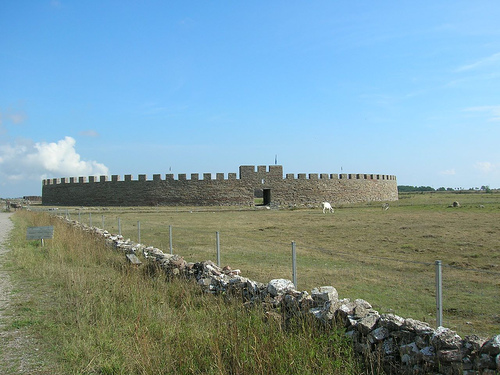

Locaton: Öland Map
Eketorp Fort, often referred to as Eketorp Castle or Eketorps borg, is a reconstructed Iron Age ringfort located in southeastern Öland, Sweden, near the town of Degerhamn in Kalmar County. Situated at coordinates 56°17′44″N 16°29′10″E, it is one of 19 prehistoric fortifications on the island of Öland, which is part of a UNESCO World Heritage Site recognized for its unique cultural landscape. Originally built around 400 AD as a defensive structure during the Nordic Iron Age, the fort has undergone multiple phases of use and abandonment, with significant reconstruction in the Middle Ages and modern times. Today, it stands as Sweden's only fully excavated and reconstructed ancient ringfort, serving as an open-air museum that brings prehistoric and medieval life to vivid reality through immersive exhibits, re-enactments, and hands-on activities. The site attracts nearly 39,000 visitors annually (as of 2019 data), offering a unique blend of archaeology, history, and family-friendly education in a flat, open landscape typical of Öland's limestone plains. Managed by the municipality of Mörbylånga since 2019, Eketorp is celebrated for its role in experimental archaeology and as a window into Sweden's ancient past.
Eketorp's history spans over 1,600 years, reflecting the
turbulent eras of migration, conflict, and settlement in northern
Europe. The fort's origins date to the Iron Age, around 400 AD,
during a time of increased contact between Öland's inhabitants and
the Roman Empire, as well as other European cultures. This initial
phase (Eketorp-I) was constructed as a refuge and gathering place
for the local agricultural community, providing protection against
external threats amid a period of instability. By the 5th century,
it expanded significantly (Eketorp-II), incorporating around 50
individual cells for habitation and storage, suggesting a more
permanent settlement. Mysteriously abandoned in the mid-7th century,
possibly due to environmental changes or social upheaval, the site
lay dormant for centuries.
In the early 11th century, during the
Middle Ages, Eketorp was rebuilt on its Iron Age foundations
(Eketorp-III), with timber structures replacing stone interiors and
an additional outer defensive wall added for enhanced protection.
This phase coincided with Öland's role in Viking-era trade and
conflicts, serving as a safe haven until its final abandonment
around 1240 AD. The fort remained in ruins until modern
archaeological interest revived it. Excavations by the Swedish
National Heritage Board from 1964 to 1974 uncovered over 24,000
artifacts, providing unprecedented insights into daily life during
these periods. Post-excavation, the site was reconstructed to its
Iron Age and medieval forms, making it a pioneer in experimental
archaeology where structures are rebuilt using ancient techniques to
test historical hypotheses. In 2005, a controversial exhibit
recreated Iron Age horse sacrifices, sparking debate but
highlighting the site's commitment to authentic representation.
Today, it stands as a testament to Sweden's prehistoric heritage,
with ongoing management ensuring its preservation.
Eketorp's architecture is characterized by its circular ringfort
design, a common feature in prehistoric Scandinavian fortifications
adapted to Öland's flat terrain for omnidirectional defense. The
original Iron Age structure (Eketorp-I) had a diameter of about 57
meters, with a simple stone wall enclosing an open area for gatherings.
In the expanded phase (Eketorp-II), the diameter grew to 80 meters,
incorporating around 50 cells—small, rectangular rooms built into the
wall for living quarters, storage, and workshops—arranged radially
around a central open space. A central water well, likely a key factor
in site selection, provided sustenance during sieges.
The medieval
reconstruction (Eketorp-III) replaced interior stone with timber
longhouses, adding a second outer defensive wall for layered protection.
Modern reconstructions faithfully replicate these phases using
traditional materials like limestone for walls and thatch or wood for
roofs, creating an authentic village-like atmosphere with houses, a
central plaza, and defensive features. The site's circular form, visible
from aerial views, emphasizes its communal and defensive purpose, with
no dominant central building to suggest egalitarian social structures.
Eketorp Fort functions as an interactive open-air museum, focusing on
experiential learning about Sweden's Iron Age and Middle Ages. Visitors
can explore reconstructed wooden houses, longhouses, and defensive
walls, with staff in period costumes demonstrating ancient crafts like
bread baking, archery, and weaving. The on-site museum in the interior
longhouses displays over 24,000 excavated artifacts, including tools,
weapons, pottery, and jewelry, providing insights into daily life,
trade, and rituals.
Summer activities (mid-June to mid-August)
include guided tours, child-focused events, and re-enactments of
medieval battles, making it particularly engaging for families.
Experimental archaeology projects, such as testing ancient building
techniques, add an educational layer. A gift shop sells souvenirs, and
the site's flat terrain allows easy exploration of the circular layout.
Controversial past exhibits, like the 2005 horse sacrifice recreation,
highlight the fort's commitment to authenticity, though they have
sparked ethical debates.
Eketorp Fort is open from Easter through late September, including
during the Öland Harvest Festival, with peak activities in summer.
Admission is charged (around 100-150 SEK for adults, based on recent
reviews; check official site for current rates), covering access to the
museum and activities. Located a few kilometers west of Route 136, the
site has an unpaved parking area about 2 km from the paved Öland
perimeter highway, making it accessible by car or bike from nearby towns
like Degerhamn. Guided tours are available, and the fort is
family-friendly with activities for children.
Tips: Visit in summer
for full programming; allow 1-2 hours for exploration. Wear comfortable
shoes for uneven terrain, and bring a picnic as facilities are limited.
Combine with other Öland attractions like nearby windmills or beaches.
Official resources: Contact Mörbylånga municipality or visit local
tourism sites for updates.